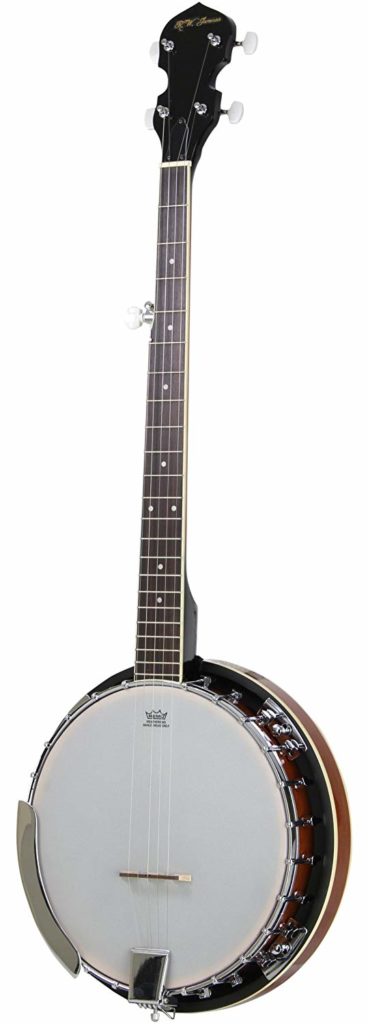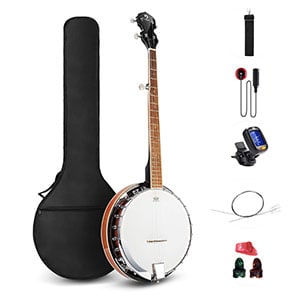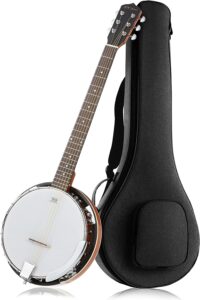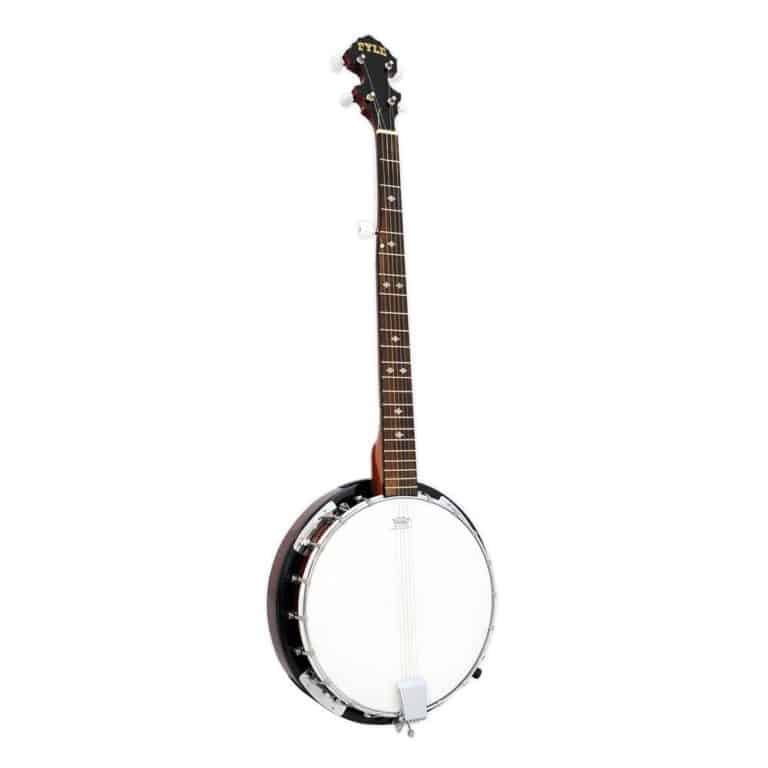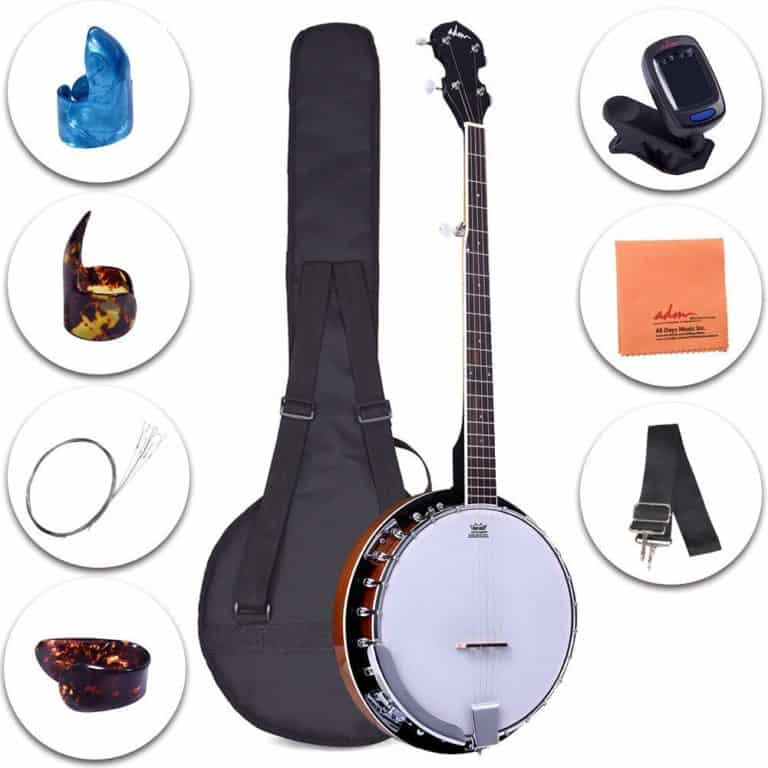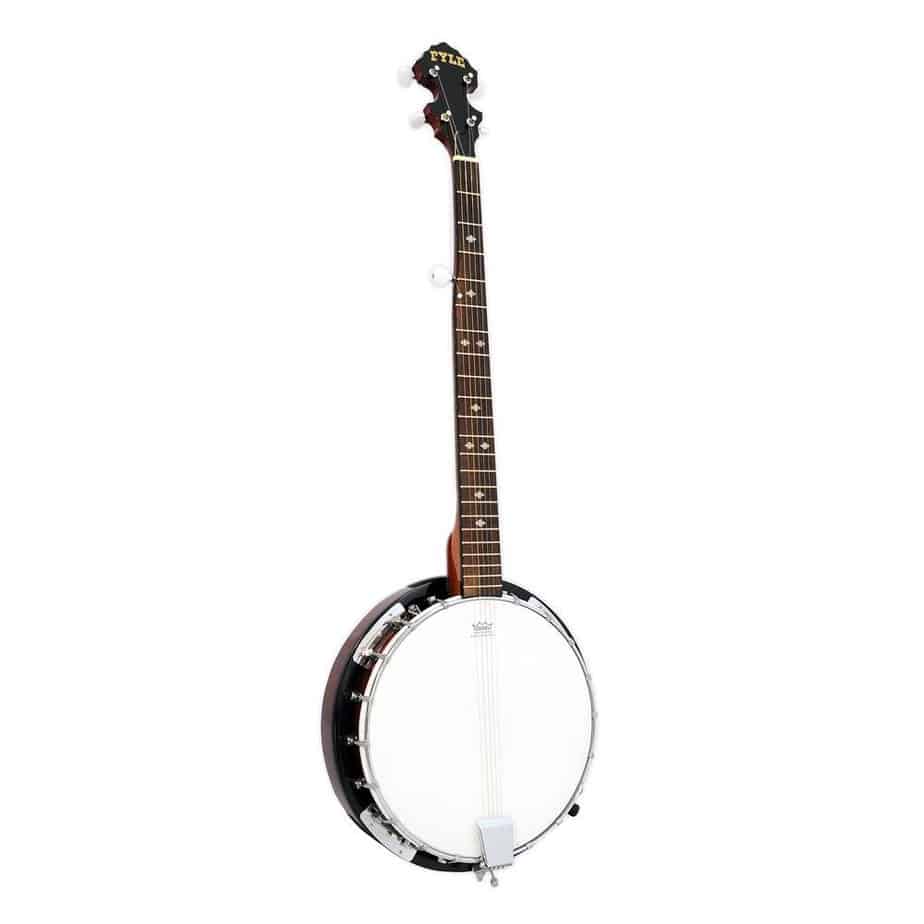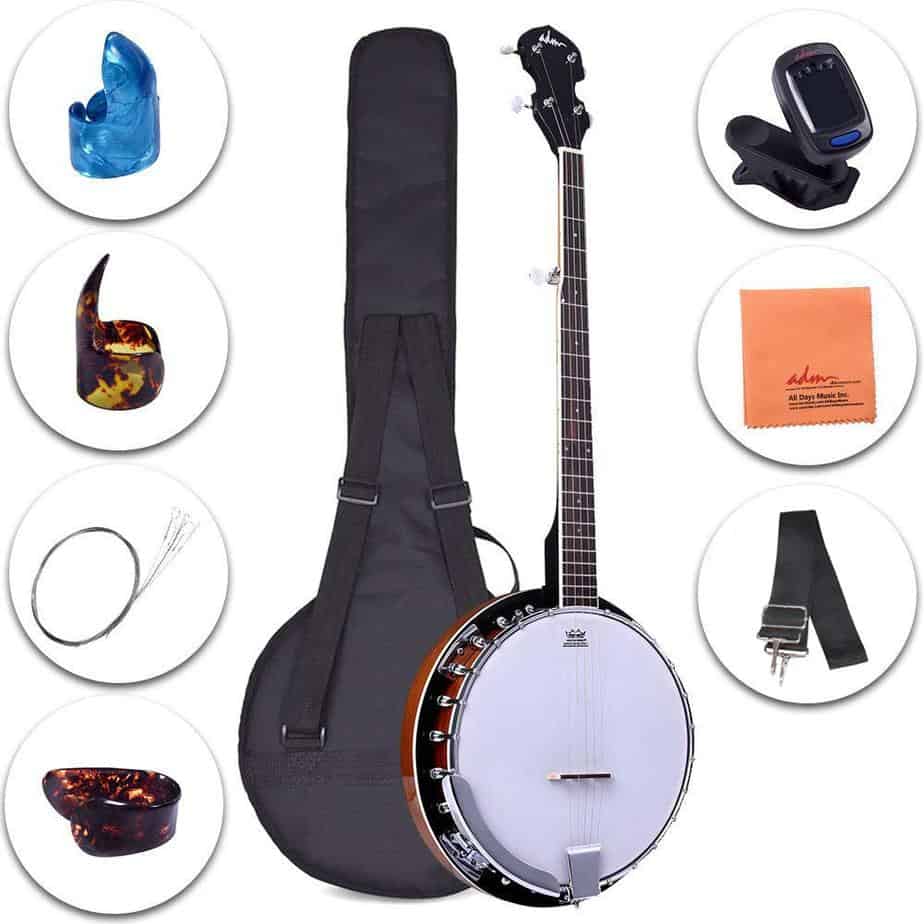A banjo is a stringed instrument, the strings can vary in number: from four to six. The top of the banjo looks like a guitar, and the lower end is shaped like a tambourine. Like a guitar, the banjo can be strummed using your fingers or with a pick. The banjo is generally used to play folk, Irish, country, and traditional music, and even rock.
Best Beginner Banjo – Buying Guide
The banjo originated from Africa and soon became a staple in North-American bands. There are several variations of a banjo: it can have an open-back resonator or a closed-back resonator. With the era changing and people wanting to learn more instruments, the banjo is on the rise again.
Best Beginner Banjo Reviews
1. Jameson Guitars 5-String Banjo
- This banjo has a mahogany resonator, and the neck is built from 7-ply maple & mahogany shell.
- The banjo also has a high-quality, glossy finish, which gives the banjo a very expensive feel and look.
- It has a geared fifth tuner, which is a more advanced version of the old friction tuner and is only found on more expensive models.
- The banjo has 24 brackets, a maple bridge, an adjustable hinged tailpiece, a chrome-plated armrest, and a bound back: all these work together to produce the classic tones of a 5-string banjo.
- The banjo has a removable resonator back, which is generally a pricy addition to banjos.
- The neck of the banjo is slip-resistant so that your fingers can easily slide up and down the fretboard for easy playing.
- The truss rods are adjustable so they can be suited to your requirements.
- Jameson is a well-known brand for banjos and has been producing excellent quality instruments for years.
This is the best beginner banjo that is affordable and can be played by both beginners and professionals.
2. Vangoa 5 String Banjo
- This banjo has high-quality mahogany back, and body and the Remo drum head produces a warm and soft sound. And beating the head can add several layers of tones to your performance.
- The mahogany wood is durable and resistant to corrosion.
- The banjo has 24 brackets for stability.
- The neck has an adjustable truss design to suit the player’s requirements.
- The banjo can be played as a resonator or as an open-back banjo by removing the back.
- The glossy finish is smooth to the touch and makes playing the banjo a fun and comfortable activity.
- The package comes along with a guitar tuner, strap, pickup, strings, and picks.
- It comes in two different sizes: the smaller one is an excellent option for beginners. Whereas professional musicians can use the regular-sized banjo.
3. Jameson 6 String Banjo Guitar
- It has diecast-enclosed tuners; therefore this banjo can be tuned like a guitar.
- It has 6 steel strings installed.
- Has a mahogany resonator, a maple neck, and a bridge.
- The glossy finish and smooth rosewood fingerboard help the player in sliding his fingers along the back of the neck easily. This makes it the best beginner banjo you can buy.
- The back of the banjo can be removed to make it an open-back instrument.
4. 5-String Geared Tunable Banjo – Pyle PBJ60
- It has machine head tuner pegs of white jade and the hardware is chrome-plated; these are just an addition to the beautiful mahogany, glossy finish of the banjo body.
- The fingerboard is of rosewood, and the bridge is of maple wood. This produces a beautiful sound and is smooth to the touch, therefore making playing the banjo a delight.
- The fifth geared tuner is excellent for both playability and tuning and is generally available in expensive banjos.
- This full-scale banjo is lightweight and therefore has easy portability and playing for beginners.
- Ideal for folk, bluegrass, and modern rock.
- Styled in the classic 20th-century manner, therefore this banjo produces the original sound it was meant for.
- The price of this banjo makes this instrument a steal; moreover, it can be used by both amateurs and professionals. Therefore, it is absolutely worth the buy.
5. ADM 5-String Banjo
- It has a geared fifth tuner, rather than the regular friction tuner that most banjos have.
- The banjo has a resonator of mahogany, and the neck is made with mahogany shell and 7-ply maple which produces a beautiful sound.
- The banjo has 24 brackets, a maple bridge, and an adjustable tailpiece to give full comfort to the player.
- There is also a chrome-plated armrest to provide ease of playing.
- The banjo has soft strings, that do not hurt your fingers when playing.
- The body is made of high-quality rosewood, which ensures that no deformation occurs in the shape of the banjo. This will also preserve the sound and produces a stable sound.
- Unlike a lot of other banjos, this one comes ready to play, and no adjustments are required to be done.
- The package comes with a gig bag, tuner, strap, an extra pair of strings, and three picks, therefore the best beginner banjo for anyone who is learning to play.
The banjos listed above don’t only have a range of prices, but they are also very different from one another in terms of their build and shape. However, what is similar among all these instruments is that they produce a beautiful sound, and despite their affordable prices, you will not have to compromise on quality. Therefore these are all excellent choices for the best beginner banjo.
How to find the best beginner banjo?
Most of your questions are answered by now, and there is only one thing left to do, which is, pick out a banjo! There are many options for a novice out there, and my job is to acquaint you with the choices so you can make a sound decision. So let’s dive into it.
The factors that you have to consider before buying a banjo are:
- It should be lightweight but long-lasting
- Strings should press down easily
- The sound should be clear
- The material it’s made of because each one has a different sound
- It should be equipped with a tuner
Now let’s look at some banjos here to help you make an informed choice.
Vangoa 5-string banjo
It is made out of high-quality mahogany wood which is durable and ideal for beginners. The package comes with all the accessories you might need. You can play it as a closed back or open back because the resonator is removable. It has 24 brackets for stability. The neck is adjustable, and you can also change the position of the strings. It comes with a glossy finish which makes the banjo look shiny and chic. It is fun and comfy to play.
Jameson Guitars 5-string banjo
This one is splendidly made with high-quality maple and mahogany structure. It also comes with a removable mahogany resonator, though it is a little hard to put the resonator back after removing it.
It comes complete with a maple bridge, 24 brackets, an adjustable tailpiece, geared fifth tuner, and a chrome-plated armrest. The glossy finish gives it a rich and expensive look. Moreover, Jameson is a very reputable and well-known brand. This banjo is the best option for beginners, and it’s used by many professionals too.
Jameson 6-string banjo guitar
This banjo, like any other 6 string banjo, plays and tunes like a guitar and sounds like a banjo. It is equipped with diecast tuners. It has a 7 ply neck and bridge and a mahogany resonator. It comes with 24 brackets, a hinged tailpiece, a maple bridge, and a chrome-plated armrest, all packed with a high-gloss finish. All of these features usually come in more expensive models, but this banjo is affordable and looks great too! It is easy to learn and fun to play. It is a good option for both beginners and professionals.
ADM 5 string banjo
It is equipped with a geared fifth tuner and needs no adjustments before playing. It is furnished with a mahogany resonator and 7 ply maple neck with a mahogany shell. It produces an elegant sound.
All the banjos named above are made with the best quality materials. They are the best and most affordable options for beginners.
You are now equipped with all the necessary facts about banjos and all that is left for you to do is to go and get one for yourself.
What is a banjo and how is it different from a guitar?
The banjo is a musical instrument that is played by using strings. It is typically used to play folk and country music, but many rock bands have used banjo in their music. Although the guitar is a more popular string instrument and there is an abundance of guitarists, banjo players are more prone to get into a band because banjoists are seldom found. Nobody wants to watch yet another wannabe rock star guitarist perform.
Difference between a banjo and a guitar:
- They are both string instruments but a guitar has 6 strings whereas the banjo has only 5(in most cases).
- Banjos are mostly played by finger picking whereas a plectrum strums a guitar.
- The body of a banjo is ordinarily smaller than a guitar and, thus, is easier to play.
- The guitar is a multifaceted instrument. Most any kind of music can be played on a guitar, but banjos are less versatile in comparison.
- The price is normally not a problem if you are a beginner. But, as you go further, a good quality banjo would cost a little more than a good guitar.
- There are more outlets for learning guitars than there are for banjos, but the banjo is a more unique instrument, and banjoists are less common than guitarists.
This gives banjoists an edge because they will be the ones to get requested to play with other musicians. After all, a new instrument is always delightful. Guitarists are very common and less likely to be invited to play with other musicians.
If more people started playing the banjo then they could give those college fresher guitarists a run for their money who learned to play the guitar only with the intent of striking other girls’ fancy!
There are a few questions that come to mind when you aspire to be a musician, but you can’t always find a reliable source to answer them. Don’t worry because we’ve got you covered.
FAQs
-
Should I get a 4-string or a 5-string banjo?
Banjos come in varied styles and structures,
- 4-string banjo- These are of two types: the plectrum and the tenor. The plectrum, as the name implies, is strummed with a guitar pick. They usually have a long necks, and their frets are situated far apart from each other. Tenor banjos came with much shorter necks, and they have the most eminent pitch. This gave way to 6 string banjos which had more low notes and were useful in producing jazz music.
- 5-string banjo- This is the most popular type of banjo. Its fifth string is shorter than the others with a tuning device at its end. This is probably the easiest type of banjo. The strings are tuned to a G chord, but there are several blends for tuning the strings relying on the type of music. Different types of music played by banjos are bluegrass, folk music, etc.
- 6-string banjo- It is a hybrid of guitar and banjo. It combines the best part of both instruments and gives you an amazing outcome. 6 string banjos come with the versatility of a guitar and the sound of a banjo. Some 6-string hybrids also come with an electric pickup, much like the electric guitar. The sound comes from an amplifier. It is tuned to the same standard tuning as a six-string guitar.
-
Is it hard to learn to play the banjo?
This is plausibly the first question that pops into your mind when you are thinking of learning a new instrument. Well, learning any instrument is not going to be easy, but it’s also not that hard. Banjo is seemingly the easiest 5 string instrument.
It’s always easy to learn the basics. Many can play a song or two in a month. Still, there will be some slips, of course. But, as the saying goes, practice makes perfect. After a while, when you play the same song, you will see that your timing has become better, your technique has enhanced, and you will be able to play more sleekly while maintaining a steady tone.
Being bodily able to control the instrument is also essential. Your fingers should move quickly on the fretboard to keep up with the tone. Making your fingers nimble will take some time. For example, it is easy to dunk a basketball once, but if you are asked to dunk ten basketballs in a row then you might fumble a few. That’s why you need to take it one at a time and not hasten through the basics. And you will be apt to play flawlessly in no time!
-
Which is easier to play, the Guitar or Banjo?
They both have their ups and downs. Some people find it more comfortable to play the banjo.
- It has fewer strings than a guitar and, hence, might be easier to comprehend.
- Banjo strings are also made of lighter gauge which makes it simpler to play. Especially because banjos are mostly finger-plucked, the strings are not hard on your tender fingers.
- Physically, banjos might be more efficient for some people because of its smaller size.
- Banjo is tuned to an open G chord and produces a pleasing sound when you strum it because it is already attuned to a chord.
- When soloing, the banjo is a better choice because you can play using three fingers. Whereas a guitarist only has a plectrum to use.
But at the end of the day, you and only you can judge whether to learn the guitar or the banjo. Reflect on which one makes you happier and then pick out your instrument.
-
How do I choose a banjo?
Now it’s time to get cracking on the anatomy of a banjo!
- Some banjos, like the claw hammer, come with an open rear end and are called open back. The open-back banjo produces a soft and gentle sound because the player’s clothes absorb the vibrations. Useful in playing folk music. It also weighs less.
- Some banjos come with a fitted resonator and are called closed back. The closed-back banjo produces a relatively powerful sound because the resonator echoes the vibrations. Beneficial in bluegrass music.
- Choose a 4-string banjo if you want to play with a plectrum.
- Pick a 6-string banjo which is a guitar-banjo hybrid. It is played like a guitar but sounds like a banjo. It comes in the same standard tuning as a guitar.
- Bluegrass banjos have low action, the distance between the strings and the fretboard.
- Choose a beginner banjo if you are on a budget. Also, check if the sound is to your desire by playing it in the store beforehand.
-
Do you need finger picks for playing the banjo?
As I stated earlier, banjo strings are often finger-plucked. Some might even say that bare fingers best play it. Most people don’t fret about the nuisance of attaching a pick to their fingers. But there are some players, mostly bluegrass, who perceive the need to play by finger picks.
Playing with finger picks brings more power and decibels to the sound because the picks are made of metal and metals are more resonant. This is important in bluegrass and rock music.
Picks are made of either metal or plastic. They are fashioned like a ring with a blade-like structure protruding from the front. It is shaped like a ring for a more solid grip. It is worn on the thumb, and then the strings are plucked by the blade-like pick. Banjos can also be plucked with regular picks that are used for guitars.
Now, it might be a little weird to play with a pick. It requires some getting used to if you are not in the habit of playing with a pick. You may face some challenges, and it will cut into your practice time.
That’s why beginners are encouraged to use picks from the start so that they are in habit of playing with picks. You can’t be expected to do a hundred pushups all at once, can you? You have to do it in sets of tens at the beginning, then do a twenty, then so on and so forth till you reach your goal.
If you buy metal picks then be sure to keep them in a pouch or some other closed place. If you keep it open then it will corrode quickly and will no longer be useful to you.
Banjos also comes with a bunch of other accessories like straps, clip-on tuners, capos, etc. You can choose whatever suits you and it makes playing the banjo more relaxed for you.
-
How long does it take to learn the banjo?
One thing to remember before learning an instrument is that the world of music is infinite. Every day you learn something new and discover something exciting. After every practice session, you are left with a hunger to learn more.
Typically it takes about one month to learn the basics and to accustom your fingers to the strings. Maybe you will be able to play a song or two in 2 months. But if you keep measuring your success by the time it took to reach there, you won’t have fun along the journey.

Hi, I am William. I am a music enthusiast. I play the guitar and ukulele. I like to try out all instruments and review them, to help others make an informed decision. You must choose the right instrument to get that sweet sound you desire. When I am not on my instruments I will be found reading or cooking.

